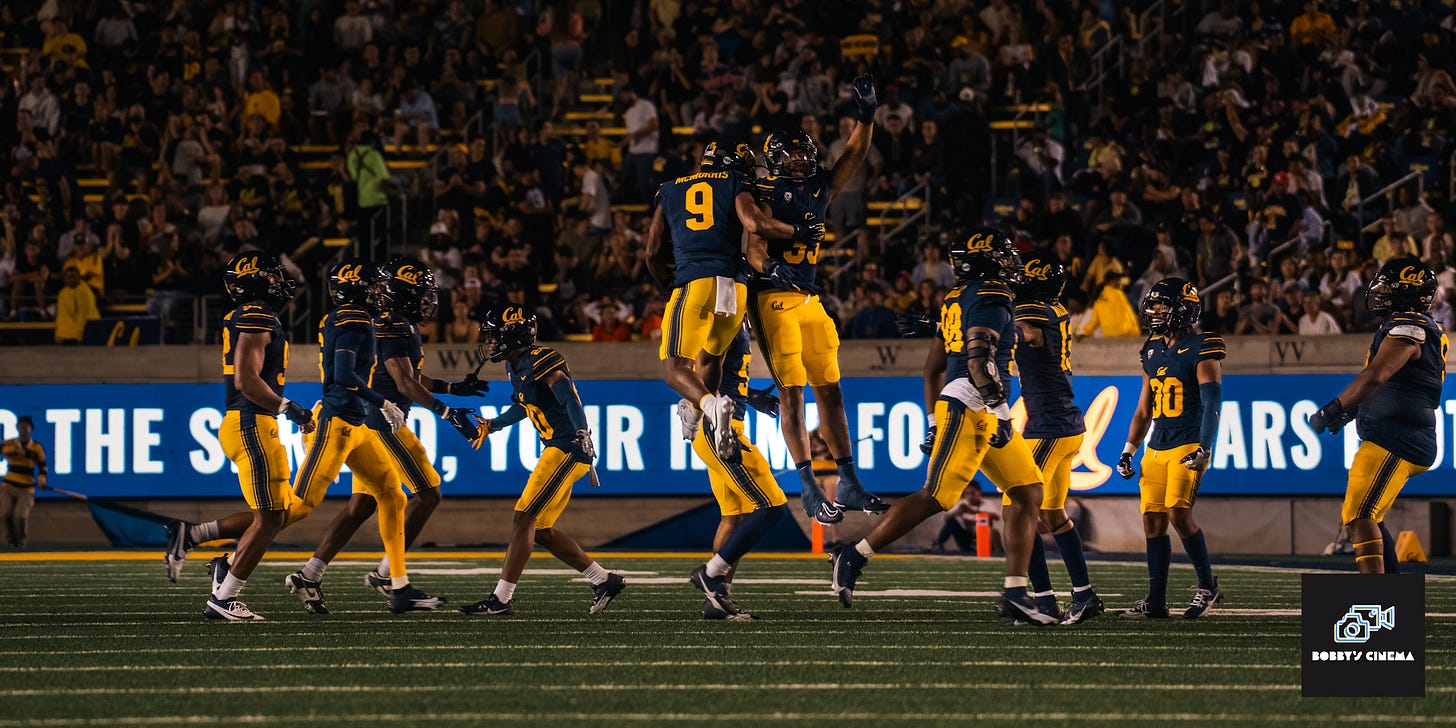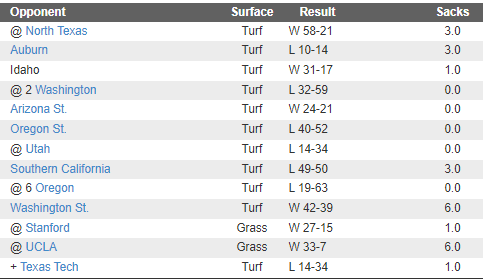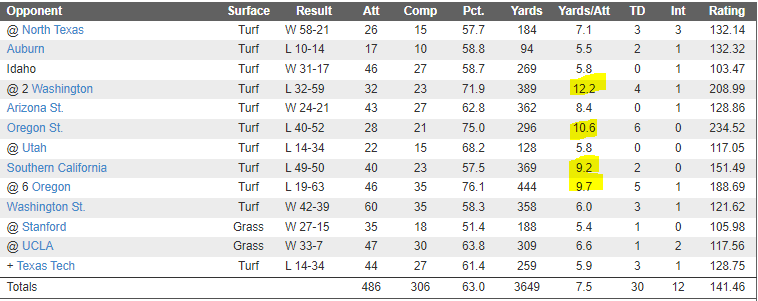2023 Football Season In Review: The Defense
Reviewing a unit that struggled against a gauntlet of elite offenses
As always, this is mostly a review of Cal’s defensive performance at large but also a review of my own predictions back in August. In case you missed it, here’s last week’s review of the Cal Offense.
2023 Defense Statistical Summary
Statistical rankings
5.8 Yards/play, 69th in the nation, 7th in the Pac-12
3.8 Yards/run, 34th in the nation, 5th in the Pac-12
7.7 Yards/pass attempt, 85th in the nation, 9th in the Pac-12
28 Turnovers gained, 1st in the nation, 1st in the Pac-12
Advanced Stats
Success Rate: 45%, 112th in the nation.
SP+: 84th in the nation, 8th in the Pac-12
FEI: 48th in the nation, 8th in the Pac-12
One might wonder about the sizeable gap between SP+’s estimation of the Cal defense and FEI’s judgment; 36 spots in the national rankings is pretty big. I think it comes down to two factors:
In FEI’s unadjusted for schedule strength rankings, Cal is 86th. FEI thinks (not unjustifiably) that the Pac-12 was an offensive buzz saw and gives a lot of leeway.
If I recall correctly, SP+ views turnovers as much more random and not a repeatable, predictive skillset, and so views Cal’s high turnover numbers (on which more below) with skepticism.
More importantly, both systems agree that Cal had the 8th best defense in the Pac-12, which is disappointing regardless. After reviewing the season, here are my Pac-12 2023 defensive tiers:
Good, top 25 level defenses: Oregon, UCLA, Utah
Solid, opportunistic defenses: Oregon State, Washington, Arizona
Iffy, bendy defenses: Washington Sate, Cal, Arizona State
Actively bad defenses: USC, Colorado, Stanford
Strengths & Weaknesses
Strength: Big run play prevention
Cal allowed just 7 runs of 20 yards or longer on the season, tied for 7th in the nation, and just three runs of 30 yards or more, tied for 11th. Teams ahead of/tied with Cal in these rankings include excellent defenses like Iowa, UCLA, Kentucky, Utah, Texas, and Penn State.
This isn’t surprising in one sense - this is typically a strength of a Justin Wilcox defense, where run fits are typically on point. But considering that Cal started the season with a redshirt freshman at one ILB spot, and ended up playing a true freshman at the other ILB spot for much of the season when Jackson Sirmon went down, THEN ended up playing a rotation of back-up ILBs in the Independence Bowl when Kaleb Elarms-Orr left for the transfer portal and STILL Cal didn’t allow a run of 20+ yards in that game.
Part of this was that Cal’s safeties were solid in run support and mopping up when things got to their level, but part of it is that Justin Wilcox knows how to coach run fits.
Weakness: QB pressure for most of the season
Cal has one of the weirdest sack distributions I can recall. Witness:
Six sacks in the first two games, albeit against G5 competition/a broken Auburn offense.
Four sacks in Cal’s next seven games
An absurd 13 sacks in three games, 5.5 of which came from David Reese, who had one of the all time pass rush heaters I’ve ever seen, more or less single-handedly beating Wazzu and UCLA by himself.
Exactly half of Cal’s season total in sacks came in just two games. Cal fans are left hoping that either 1. David Reese gets another year of eligibility, comes back, and proves that his late season surge wasn’t just a random blip or 2. Cal finds consistent pass rushers via the transfer portal . . . which is a skill set in high demand and low supply.
Strength: Forcing turnovers
Cal forced 18 fumbles (2nd in the nation), and recovered 16 of them (1st), and that’s one of the luckiest stats I can recall seeing in my years of tracking this kind of stuff.
When I say luck I more so mean that Cal recovered such an absurdly high percentage of forced fumbles. It’s also probably true that the number of forced fumbles isn’t particularly sustainable, unless David Reese has a particular knack for timing his edge rushes such that he always gets to the QB right when he’s cocking his arm to throw.
And Cal’s turnover bonanza was mostly fumble fueled - 12 interceptions is a good number, but hardly far from the national average.
Weakness: Finishing drives when a turnover isn’t forced
Cal’s defensive 3rd down conversion percentage: 98th
Cal’s defensive 4th down conversion percentage: 109th
Cal’s defensive red zone scoring percentage: 108th
Cal’s defensive red zone touchdown percentage: 120th
The defining problem of Cal’s season was an inability to end drives when the defense wasn’t forcing turnovers. And I’ll throw in one more telling number: Cal’s opponents attempted 38 4th downs all year long; only ONE team in the country faced more 4th down attempts.
I think these numbers reflect a few things: firstly, that Cal struggled to keep teams off schedule. When Cal DID forced a 3rd or 4th down, they were typically short yardage conversion that teams were confident to attempt. Secondly, that opponents were often driving deep into Cal territory such that it made sense to go for it. and Thirdly, Cal faced a bunch of good, confident offenses more likely to go for it regardless of opponent.
Answers to Pre-Season Defining Questions
Will Brett Johnson be healthy, and is he the solution to world hunger and/or Cal’s front 4 woes?
Yes, and mostly no. Brett Johnson was a valuable player to have back on the field, but he was not a dominant force in the middle of Cal’s defensive line. In fact, I’d say that he was probably the 2nd best player in Cal’s interior defensive line rotation, behind Ricky Correia.
Adding a roughly Pac-12 average player to the rotation as a position with depth and injury issues was certainly a plus, and I think Brett played a role in Cal’s success in the run game. But I think his injuries robbed him of some of the explosiveness and first step quickness that wowed us back in 2020. Life is cruel.
Can any of Cal’s OLBs take a big step forward?
Sadly, I think the answer here is a qualified no. Cal started the season with Xavier Carlton and Myles Jernigan at OLB, and over the course of the season Jernigan gradually ceded more and more snaps to David Reese, who eventually took over as starter.
Carlton 100% took a step forward in all aspects, particularly in his run support. And the step from ‘slightly below average P5 player’ to ‘slightly above average P5 player’ is not insignificant. It’s just that Cal needed a consistent threat
Meanwhile, Reese, as mentioned above, struggled to make an impact until going absolutely hog wild against UCLA and Wazzu. Ultimately, I think I’d prefer a player who is more consistent game to game and down to down like Carlton but who struggles to make huge plays, but it’s hard to look past the absolutely game changing plays Reese made in two contests.
Who plays ILB alongside Jackson Sirmon?
Sigh. Kaleb Elarms-Orr was, as a redshirt freshman, an all-around solid player who appeared to be a building block for future Cal defenses. He will be playing for TCU next year after entering the transfer portal.
Cal’s new foundational piece at ILB is, hopefully, Cade Uluave, who struggled at times with tackling and coverage assignments but showed an instinctual nose for the ball that is harder to teach. If Wilcox and company can iron out some the rougher elements of his game, he could be a major impact player for a long time in Berkeley . . . but that still leaves Cal one ILB short. Teddye Buchanan, come on down!
Predictions in Review
Cal’s defense almost certainly should be better than last season. Of the 16 players who got the most snaps last year, only two (Daniel Scott and Oluwafemi Oladejo) are no longer on the roster.
Cal’s defense was not, in fact, better than 2022!
I don’t think Brett Johnson by himself is enough, and I don’t think Cal added enough depth and top end talent on the edge to truly disrupt the various Heisman candidates that will pop up ever couple of weeks on Cal’s schedule. I’m currently penciling Cal in for the 4th best defense in the conference, and probably somewhere in the 40s nationally once you adjust for schedule strength
Sigh. I was tempering my own expectations by acknowledging some of Cal’s limitations, and it still wasn’t quite pessimistic enough. Which brings us to the defining question of 2023 for the Cal defense:
How did a defense that only lost one major contributor from the 2022 secondary (Daniel Scott) and then added a bunch of solid DB transfers who ended up playing over many DBs who were still on the roster in 2023 get worse?
I don’t think it was the pass rush - in fact, the 2023 pass rush was a slight improvement on 2022.
Possible explanations:
Daniel Scott was in fact that good, and Patrick McMorris was unable to match his impact.
The Pac-12 in 2023 was the single most stacked collection of offenses in conference history and Cal was an innocent victim of an inevitable murderer’s row.
There is something off about Cal’s talent identification and/or development and/or schematic coaching in the secondary.
I’m not going to try super hard to convince you of any of the above three over the others, since I think all of them are factors, but it’s worth noting:
Four games really stood out as rough days for Cal’s pass defense, and they all came against the four best offenses with pro level QBs the kind of which will be much rare in the ACC.
Which isn’t to say that the scale with which UW, OSU, USC, and Oregon torched Cal is encouraging, or that Cal doesn’t need to get better. But I do think it’s hard to underestimate the extent to which a historic level of offensive firepower swept through west coast football this year.
Meaning, if we’re back here in a year marveling at how much improvement we saw from Cal’s defense in 2024, remember how much difference schedule strength can make.
Caleb Williams and Bo Nix and Michael Penix aren’t around any more to torture us. Meanwhile, Justin Wilcox and company have an off-season to make sure that they don’t allow ACC offenses to go off like Pac-12 offenses did.





Little over a month since our season really ended and right now all of us are “so you’re saying there’s a chance” hahahah I love it hahaha
"There is something off about Cal’s talent identification...", or at least Calfans. The talent isn't as good, as deep, and as (important) varied as it needs to be to consistently math up with the wide variety of opponents they encounter over the course of a season, and sometimes a game. But when they do for a game or series, expectations automatically and immediately ratchet up to unsustainable levels with the spotty/limited talent on hand.